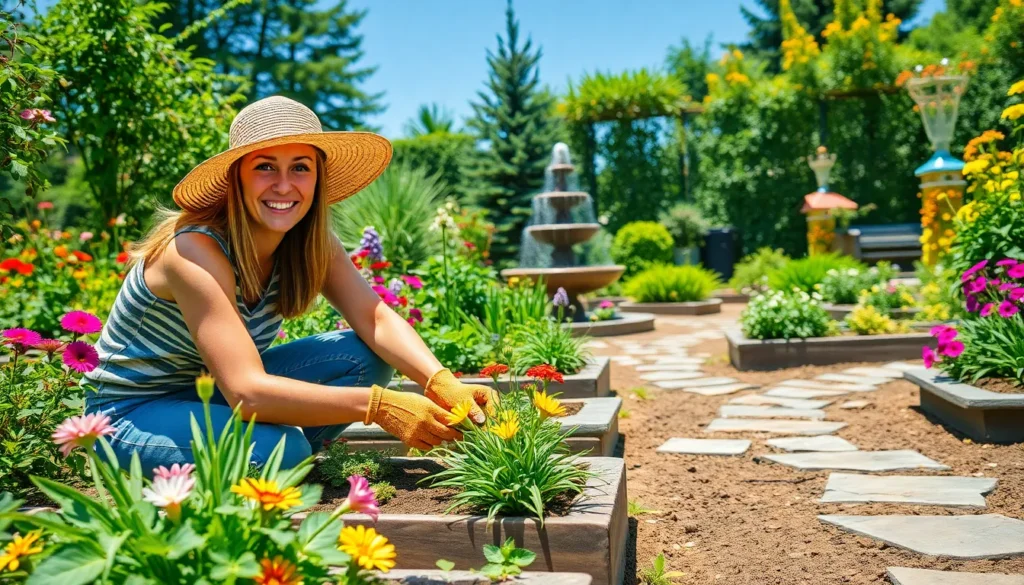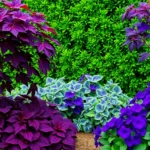Transforming your outdoor space into a stunning garden paradise doesn’t require a complete overhaul or a massive budget. We’ve discovered that the most impactful garden renovations often come from strategic changes that maximize both beauty and functionality.
Whether you’re working with a small backyard plot or sprawling acres, we understand that every garden has untapped potential waiting to be unleashed. The key lies in identifying which renovation ideas will deliver the biggest visual impact while complementing your lifestyle and maintenance preferences.
From simple weekend projects that instantly boost curb appeal to more ambitious transformations that create true outdoor living spaces, we’ll guide you through proven garden renovation strategies that work. These aren’t just pretty ideas – they’re practical answers that real homeowners have used to dramatically increase their property value and outdoor enjoyment.
Create a Stunning Garden Layout Plan
Planning forms the foundation of every successful garden renovation project. We’ll guide you through developing a comprehensive layout that maximizes your space’s potential.
Assess Your Current Space and Conditions
Measure your garden dimensions to create an accurate base map for renovation planning. We recommend using a measuring tape to record length and width measurements, noting any irregular shapes or obstacles like existing trees, structures, or utility lines.
Document sunlight patterns throughout different times of day to identify full sun, partial shade, and full shade areas. We suggest observing your space during morning (6-10 AM), midday (10 AM-2 PM), and afternoon (2-6 PM) periods across several days to understand light variations.
Test your soil quality using a simple pH testing kit available at garden centers for $10-15. We find that most vegetables and flowers thrive in soil with pH levels between 6.0 and 7.0, while acid-loving plants like blueberries and azaleas prefer pH levels of 4.5-5.5.
Evaluate drainage conditions by digging test holes 12 inches deep in various locations after rainfall. We check if water remains standing after 24 hours, which indicates poor drainage requiring amendments like raised beds or French drains.
Identify existing features worth preserving, such as mature trees, established perennials, or hardscape elements like pathways and retaining walls. We photograph these elements from multiple angles to reference during the design process.
Design Functional Garden Zones
Divide your space into distinct activity zones based on how you’ll use each area. We typically recommend creating zones for dining, relaxation, play areas, vegetable gardening, and ornamental displays to maximize functionality.
Establish primary pathways connecting major zones with materials like flagstone, gravel, or mulch that complement your overall design. We suggest making main pathways 4-5 feet wide to accommodate two people walking side by side comfortably.
Position high-maintenance areas like vegetable gardens and herb beds close to water sources and your home’s entrance. We place these within 50-100 feet of the house to encourage regular tending and harvesting activities.
Create privacy screens using strategic plant placement, trellises, or fencing to separate different zones while maintaining visual flow. We use evergreen shrubs like boxwood or privet, which provide year-round screening at heights of 3-8 feet.
Plan seasonal interest by incorporating plants that bloom or show color during different months. We include spring bulbs like tulips and daffodils, summer perennials like coneflowers and black-eyed Susans, fall favorites like asters and mums, and winter elements like ornamental grasses and berry-producing shrubs.
Choose a Cohesive Style Theme
Select a unifying design style that reflects your personal preferences and complements your home’s architecture. We recommend choosing from popular styles like cottage gardens with mixed plantings, modern minimalist designs with clean lines, Mediterranean themes featuring drought-tolerant plants, or traditional formal gardens with symmetrical layouts.
Develop a consistent color palette using 2-3 primary colors repeated throughout different garden zones. We often use combinations like purple and yellow with white accents, or pink and blue with silver foliage to create visual harmony across the entire space.
Repeat key materials for hardscape elements like pathways, edging, and containers to maintain design consistency. We suggest using the same stone, brick, or metal finishes in multiple applications rather than mixing too many different materials.
Choose plants with similar growing requirements that naturally complement each other while fitting your chosen style. We group plants by water needs, sun exposure, and maintenance requirements to create sustainable combinations that thrive together.
Incorporate signature elements that reinforce your chosen theme, such as rustic wooden benches for cottage gardens, sculptural planters for modern designs, or terra cotta containers for Mediterranean styles. We add these focal points strategically to strengthen the overall design narrative.
Transform Your Garden with Hardscaping Elements
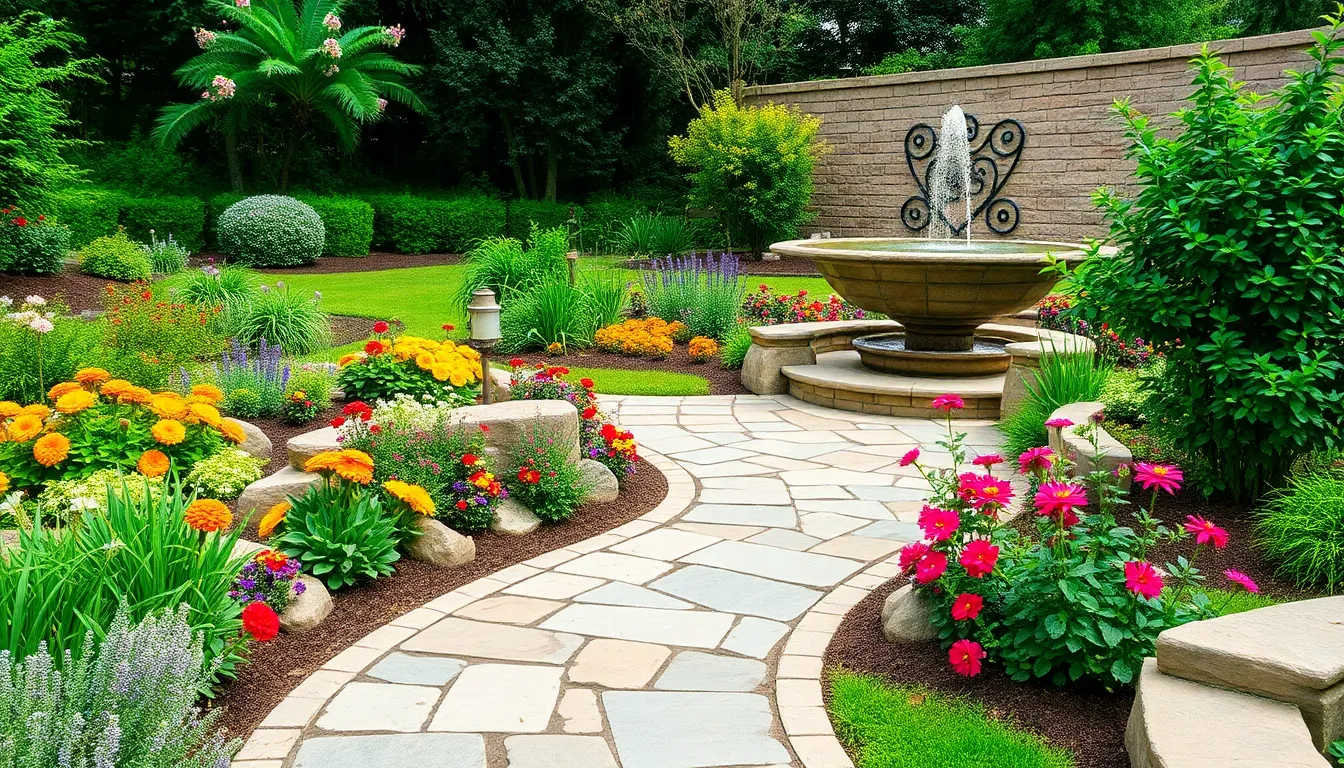
Hardscaping elements form the backbone of successful garden renovations by creating structure and visual interest that lasts year-round. These permanent features define spaces and establish pathways that enhance both functionality and aesthetic appeal.
Install Decorative Pathways and Walkways
Installing decorative pathways creates clear navigation routes while adding visual appeal to your garden layout. Stone materials like flagstone or slate offer durability and natural beauty that complements most garden styles. Brick pathways provide classic charm and work exceptionally well with traditional home architectures. Gravel paths deliver budget-friendly options that allow for easy drainage and can be customized with different colors and textures.
We recommend planning pathway width between 3-4 feet for main routes and 2-3 feet for secondary walkways to ensure comfortable passage. Materials should connect with your home’s exterior elements like porch railings or foundation stones for cohesive design flow. Curved pathways create more interesting visual journeys compared to straight lines and help soften formal garden layouts.
Add Retaining Walls and Raised Beds
Adding retaining walls solves grading challenges while creating opportunities for terraced planting areas that prevent soil erosion. These structures work particularly well on sloped properties where traditional planting becomes difficult or ineffective. Stone or concrete block walls provide long-lasting answers that can double as seating areas in smaller gardens.
Raised beds improve drainage conditions and make maintenance tasks more comfortable by reducing bending and kneeling. Building beds 18-24 inches high creates optimal growing conditions for most vegetables and flowers while remaining accessible for gardening activities. We suggest using cedar or composite materials for raised bed construction since these options resist weather damage better than untreated wood alternatives.
Incorporate Water Features and Fountains
Incorporating water features creates focal points that enhance garden ambiance through sound and movement. Small ponds attract beneficial wildlife like birds and butterflies, which helps establish more vibrant garden ecosystems. Fountains provide soothing water sounds that mask neighborhood noise while creating peaceful outdoor environments.
We find that recirculating water systems work best for most residential gardens since they require minimal maintenance compared to natural pond ecosystems. Solar-powered fountain pumps offer eco-friendly operation without requiring electrical connections in remote garden areas. Wall-mounted water features maximize impact in smaller spaces where ground-level installations might overwhelm the available area.
Revitalize Your Plant Selection and Garden Beds
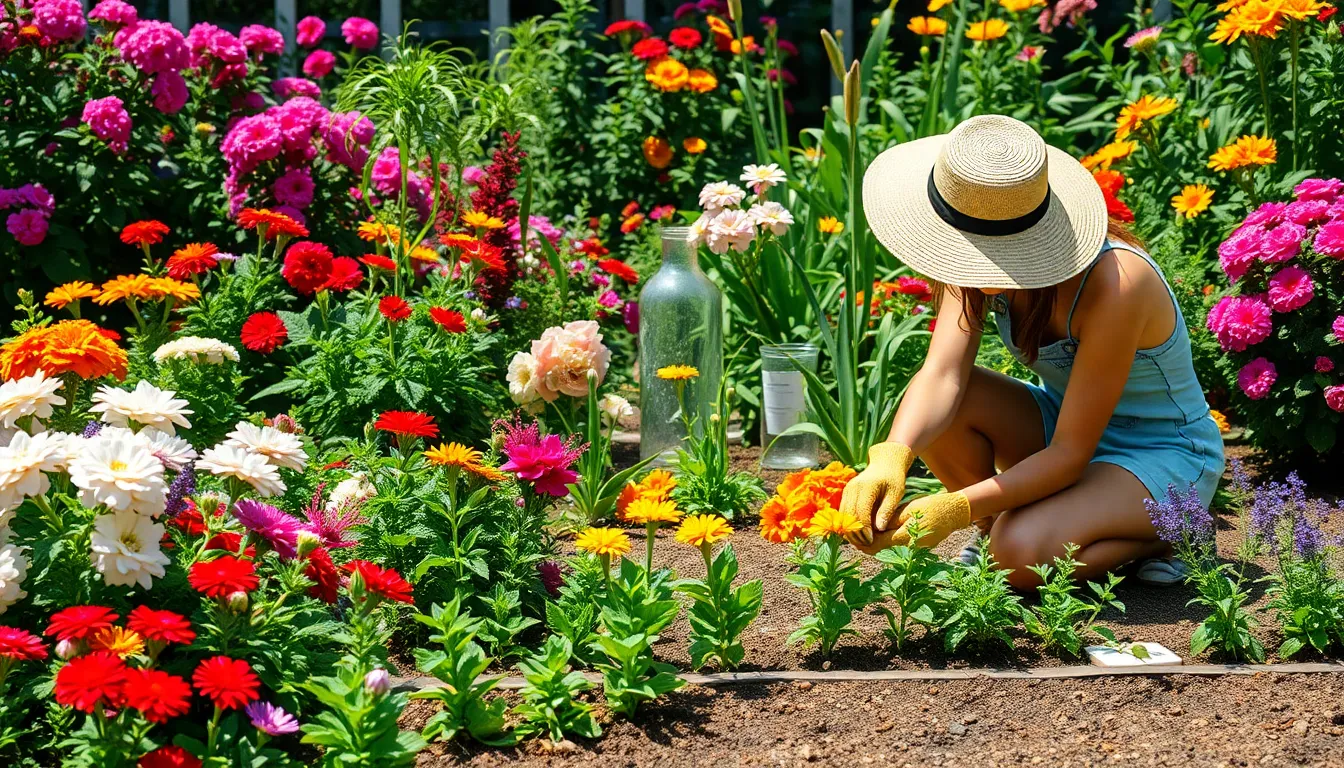
Transforming your garden’s foundation starts with thoughtful plant selection and strategic bed renovation. We’ll show you proven methods to refresh overgrown areas and create ever-changing plantings that deliver year-round beauty with minimal upkeep.
Replace Overgrown or Damaged Plants
Removing struggling specimens creates space for healthier growth and renewed garden design. We recommend starting with a thorough assessment of existing plants to identify those that have outgrown their allocated space or show signs of disease and decline.
Clearing damaged vegetation immediately improves both visual appeal and overall garden health. Plants that compete for resources or harbor pests should be your first priority for removal, making room for specimens better suited to your exact growing conditions.
Selecting replacement plants that thrive in local conditions ensures long-term success and reduces maintenance demands. We suggest choosing species native to your region or proven performers that match your soil type, sunlight exposure, and climate zone.
Create Seasonal Interest with Diverse Plantings
Incorporating staggered bloom times delivers continuous color and texture throughout the growing season. We recommend combining spring bulbs like tulips and daffodils with summer perennials such as coneflowers and black-eyed Susans, followed by fall grasses and evergreen shrubs for winter structure.
Layering different plant heights creates visual depth and maximizes garden impact. Tall ornamental grasses serve as backdrops for medium-height perennials, while low-growing groundcovers fill gaps and suppress weeds between larger specimens.
Varying foliage textures and colors adds interest even when flowers aren’t blooming. We suggest mixing broad-leafed hostas with fine-textured ferns and spiky iris leaves to create compelling contrasts that engage the eye year-round.
Establish Low-Maintenance Perennial Gardens
Prioritizing drought-tolerant native species reduces watering requirements while supporting local wildlife and pollinators. Yarrow, catmint, and blue hibiscus exemplify plants that provide long-lasting blooms with minimal care once established.
Grouping plants with similar water needs simplifies irrigation and prevents overwatering damage to drought-adapted specimens. We recommend creating separate zones for moisture-loving plants like astilbe and ferns versus xeric plants like sedums and ornamental grasses.
Embracing maximalist planting styles reflects current trends toward naturalistic, lush gardens over minimalist designs. Dense, varied plantings with multiple colors and textures create immersive, nature-focused spaces that deliver sensory richness and ecological benefits.
Upgrade Your Garden’s Outdoor Living Spaces
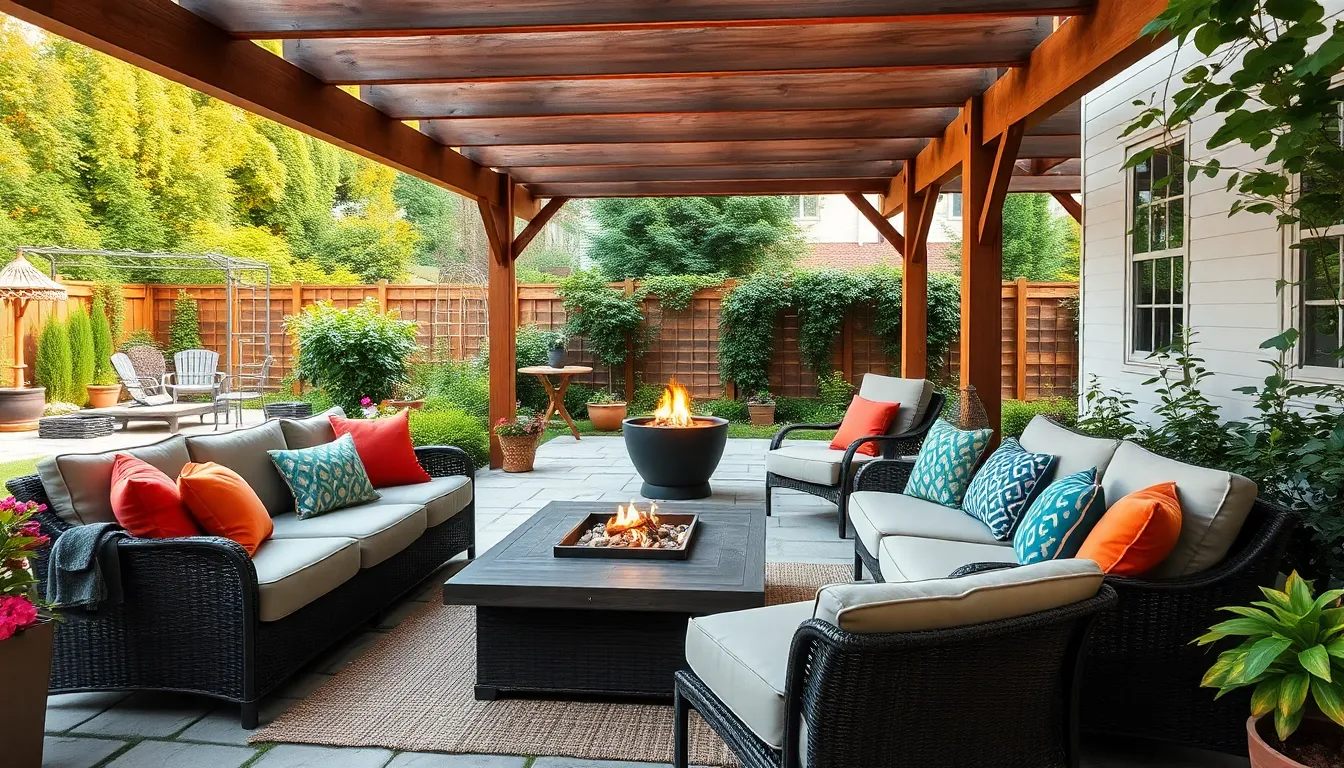
Transforming your garden into functional outdoor living spaces extends your home’s usable area while creating inviting environments for relaxation and entertainment. Smart upgrades blend seamlessly with your existing industry design to maximize both comfort and aesthetic appeal.
Build a Cozy Seating Area or Patio
Creating comfortable outdoor seating transforms any garden space into a welcoming retreat. We recommend incorporating durable outdoor furniture like sofas, lounge chairs, and coffee tables that can withstand weather elements while providing comfort for daily use. Weatherproof cushions, throw blankets, and outdoor rugs instantly add coziness and create distinct conversation areas within your garden layout.
Fire pits and outdoor fireplaces serve as natural gathering points that extend your outdoor season. Installing these warming features adds both ambiance and functionality, making your seating area inviting throughout cooler months. Consider portable fire bowls for flexibility or built-in fire features for permanent focal points that complement your hardscaping elements.
Smart lighting systems enhance evening ambiance while improving safety and functionality. We suggest installing LED pathway lights along walkways and accent lighting around seating areas to create beautiful nighttime atmospheres. Solar-powered options reduce energy costs while providing consistent illumination for your outdoor living spaces.
Install Pergolas and Garden Structures
Pergolas provide essential shade coverage while creating stunning architectural frameworks for your outdoor rooms. Installing these structures over patios or seating areas offers protection from sun and light rain while supporting climbing plants that add natural beauty. Choose materials like cedar or aluminum that complement your home’s architecture and require minimal maintenance over time.
Climbing plants transform pergolas into living canopies that enhance privacy and visual appeal. We recommend selecting vigorous climbers like clematis, jasmine, or grape vines that thrive in your local climate conditions. These plantings create natural screening while contributing to your garden’s seasonal interest throughout the year.
Strategic placement of garden structures maximizes both function and aesthetic impact. Position pergolas to frame views of key industry features or create intimate dining nooks within larger garden spaces. Consider height variations and sight lines to ensure your structures enhance rather than obstruct your overall garden design.
Create Dining and Entertainment Zones
Outdoor kitchens establish dedicated cooking spaces that help seamless entertaining and meal preparation. We suggest incorporating essential elements like grills, prep areas, and weatherproof storage to create fully functional cooking stations. Built-in features like countertops and cabinets provide convenience while maintaining clean design lines that complement your garden’s aesthetic.
Designated dining areas with weatherproof furniture create comfortable spaces for outdoor meals and gatherings. Choose dining sets that accommodate your typical guest count while fitting proportionally within your available space. Add pergolas or retractable canopies over dining zones to provide shade options during peak sun hours.
Water features like ponds, fountains, or streams enhance the ambiance of entertainment areas while attracting beneficial wildlife. Installing recirculating systems ensures low maintenance requirements while providing soothing background sounds that mask neighborhood noise. Solar-powered pumps offer energy-efficient operation that aligns with sustainable garden practices.
Multifunctional design approaches maximize utility within entertainment zones by incorporating flexible furniture and adaptable layouts. We recommend modular seating arrangements that can be reconfigured for different group sizes and activities. Storage ottomans and side tables with built-in compartments help maintain organized outdoor spaces while serving multiple purposes.
Enhance Garden Lighting and Ambiance
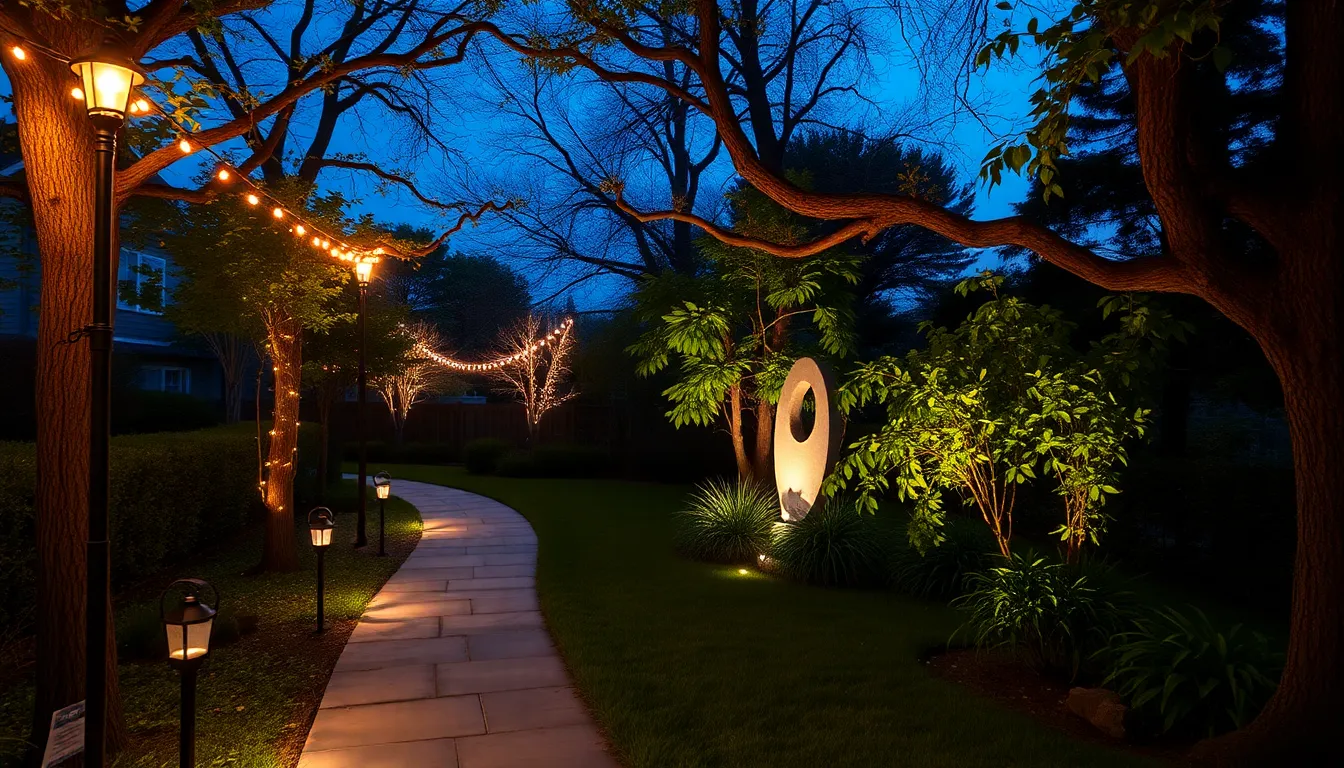
Garden lighting transforms outdoor spaces into enchanting evening retreats while providing essential safety and security benefits. Strategic illumination creates depth and visual interest that extends your garden’s usable hours well beyond sunset.
Add Pathway and Security Lighting
Solar powered lights offer the most sustainable solution for illuminating walkways and entry points throughout your garden space. These eco-friendly fixtures reduce energy consumption while providing reliable illumination that automatically activates at dusk. Position solar lights along main pathways every 6-8 feet to ensure consistent visibility and safe passage.
Spotlights create dramatic effects when strategically placed to highlight architectural features, water elements, or prized plantings. Install adjustable spotlights near garden entrances and corners to enhance security while showcasing your industry’s best attributes. LED spotlights consume minimal energy and offer superior longevity compared to traditional lighting options.
Motion sensor lights provide additional security layers while conserving energy through automatic activation systems. Mount these fixtures at appropriate heights along frequently traveled routes and near outdoor seating areas. Consider warm-toned LED bulbs that complement natural garden colors rather than harsh white lighting.
Install Decorative String Lights and Lanterns
String lights infuse magical ambiance into evening garden settings through their warm, diffused illumination patterns. Drape weather-resistant string lights along fence lines, through tree branches, or around pergola structures to create inviting atmospheric effects. Choose dimmable options that allow customization based on exact occasions or seasonal preferences.
Lanterns add sculptural elements while providing functional lighting answers throughout various garden zones. Select lanterns in complementary colors and shapes that enhance your established design theme rather than competing with existing elements. Solar powered lanterns eliminate wiring concerns while offering placement flexibility in remote garden areas.
Bistro lights create restaurant quality ambiance over dining areas and entertainment spaces with their larger bulb sizes and enhanced brightness levels. String these fixtures overhead between posts or trees to define outdoor rooms and establish intimate gathering spaces. Consider Edison style bulbs for vintage appeal or colored options for festive occasions.
Highlight Key Features with Accent Lighting
Accent lighting draws attention to your garden’s most spectacular features through carefully positioned illumination that creates focal points after dark. Use adjustable spotlights to showcase sculptures, specimen trees, or architectural elements that define your industry’s character. Position lights at various angles to avoid harsh shadows while creating dimensional depth.
Layered lighting combines multiple illumination types to achieve professional industry lighting effects that rival commercial installations. Blend pathway lights with accent spotlights and ambient string lighting to create sophisticated evening atmospheres. This approach allows independent control over different lighting zones based on exact activities or moods.
Uplighting emphasizes vertical garden elements like mature trees, tall grasses, or climbing plants through ground level fixtures that project illumination upward. Install these lights several feet away from plant bases to create dramatic silhouettes without causing heat damage. Consider color changing LED options that adapt to seasonal celebrations or personal preferences.
Implement Smart Irrigation and Maintenance Systems
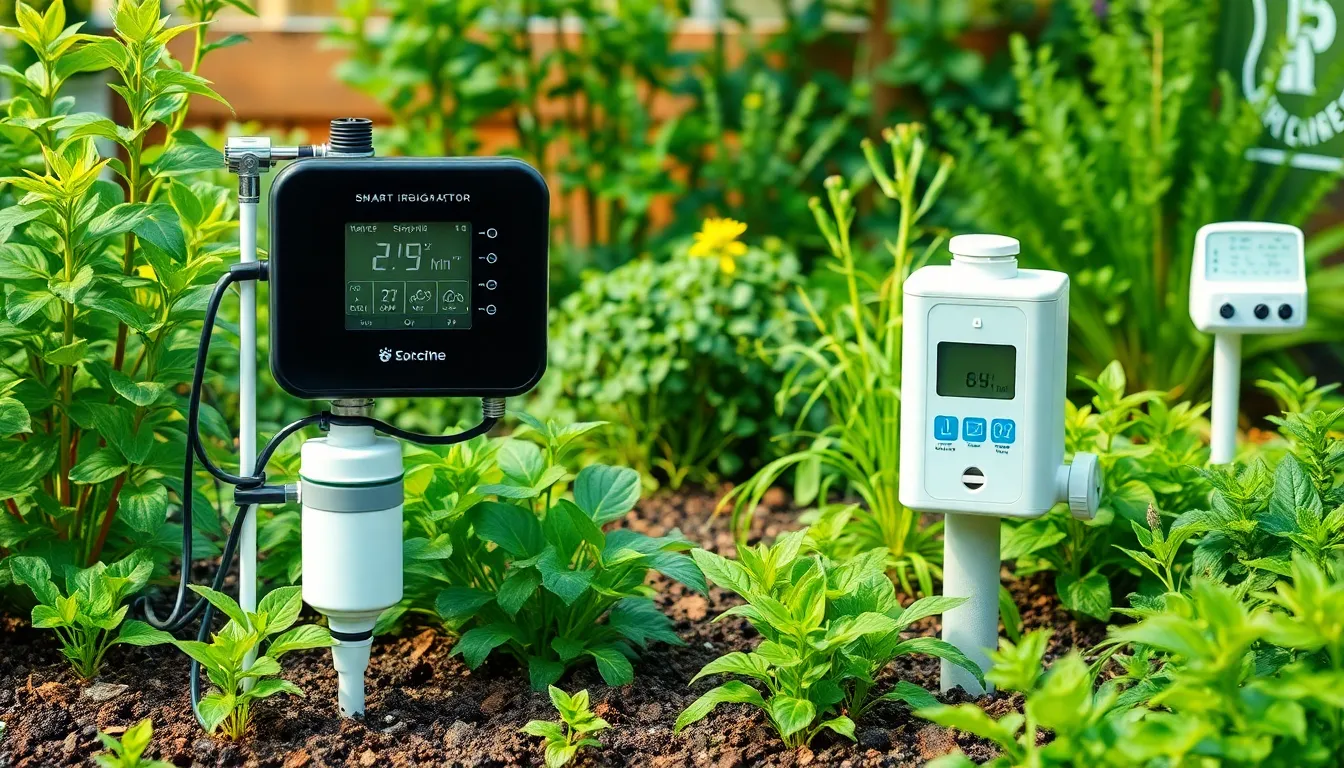
Modern technology transforms garden care from a time-consuming chore into an automated process that saves both water and effort. We’ll explore how smart systems can revolutionize your garden maintenance routine.
Upgrade to Efficient Watering Answers
Drip irrigation systems deliver water directly to plant roots, reducing water waste by up to 50% compared to traditional sprinklers. These systems minimize evaporation and runoff while ensuring consistent moisture for your plants.
Digital sprinkler technology takes precision watering to the next level with AI-designed systems like Irrigreen that map your yard and deliver water only where needed. The technology eliminates overwatering and dry spots by creating customized watering patterns for each section of your garden.
Smart watering controllers adjust irrigation schedules automatically based on weather forecasts, soil moisture levels, and seasonal changes. Systems like RainPoint and Orbit B-hyve connect to weather stations and postpone watering during rain, wind, or freeze events to prevent water waste.
Soil sensors monitor moisture levels in real time and trigger watering only when plants need it. This prevents both overwatering and drought stress while reducing your water bill by 20-30%.
Install Automated Garden Care Systems
Smart home integration connects your garden to voice assistants and smartphone apps for complete remote control. BRESSER Smart Garden systems allow you to monitor and adjust watering schedules from anywhere using Alexa, Google Assistant, or dedicated mobile apps.
Automated rain delay systems pause irrigation when weather conditions make watering unnecessary or harmful. These systems detect precipitation, high winds, and freezing temperatures to protect both your plants and water conservation efforts.
Weather monitoring stations provide hyperlocal data for your exact garden location, tracking temperature, humidity, wind speed, and rainfall. This information feeds into smart controllers to optimize watering schedules and garden care timing.
Remote monitoring capabilities send alerts to your phone when systems need attention or when unusual conditions occur. You’ll receive notifications about low water pressure, broken sprinkler heads, or extreme weather events that could affect your garden.
Create Composting and Storage Areas
Designated composting zones transform kitchen scraps and yard waste into nutrient-rich soil amendments while reducing household waste by 30%. Position compost bins in partially shaded areas with good drainage and easy access from both kitchen and garden.
Tool storage answers keep expensive gardening equipment organized and protected from weather damage. Build cedar storage benches or install weather-resistant cabinets near your main gardening areas for quick access to frequently used tools.
Supply organization systems reduce time spent searching for materials and help track inventory levels. Install shelving units or pegboard systems in garden sheds to store fertilizers, seeds, pest control products, and seasonal decorations.
Maintenance scheduling stations centralize garden care information with weatherproof calendars and checklists. Mount a covered bulletin board near your storage area to track fertilizing schedules, pruning dates, and seasonal tasks.
Add Privacy and Screening Solutions
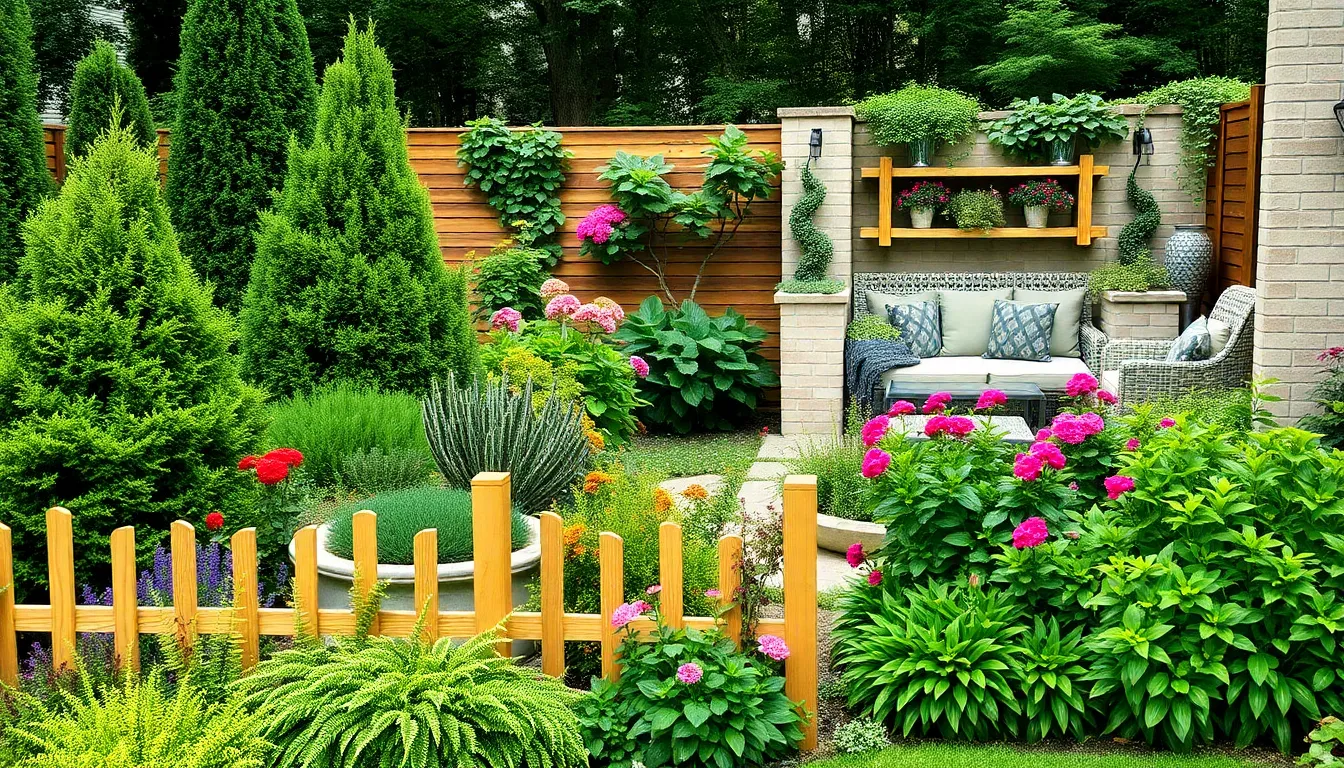
Privacy transforms any garden into a peaceful retreat where we can relax without feeling exposed to neighbors or street traffic. Strategic screening answers create intimate outdoor spaces while adding architectural interest to our industry design.
Plant Natural Privacy Hedges and Screens
Lush shrubs like laurel, holly, rhododendron, and photinia create natural privacy screens that provide year-round coverage. These evergreen options maintain their screening effectiveness throughout all seasons while adding texture and color to our garden borders.
Fast-growing shrubs such as privet and forsythia deliver quick results when we need immediate privacy answers. Privet can grow up to 3 feet per year, making it an excellent choice for establishing screening within just a few growing seasons.
Layered plantings combine different shrub heights to create visual depth while maximizing privacy coverage. We can plant taller screening shrubs like rhododendron in the back, medium-height holly in the middle, and lower border plants in front for a natural, tiered effect.
Install Decorative Fencing and Trellises
Decorative fencing enhances our garden’s visual appeal while providing functional privacy screening. Modern fence designs incorporate materials like cedar, bamboo, or composite materials that complement our industry style without appearing purely utilitarian.
Trellises offer versatile screening options when added to existing fence tops or used as standalone privacy features. These structures support climbing plants while creating immediate visual barriers that soften over time as vegetation grows.
Combination answers maximize both form and function by pairing solid fence panels with trellis sections. This approach provides solid privacy where we need it most while allowing filtered light and air circulation in other areas.
Create Intimate Garden Rooms
Free-standing walls divide larger garden spaces into cozy, functional areas without requiring permanent structural changes. These partial walls can incorporate built-in planters or seating to serve multiple purposes within our industry design.
Garden awnings provide both shade and screening while creating defined outdoor living spaces. Retractable awnings offer flexibility to adjust privacy and sun protection based on weather conditions and our immediate needs.
Strategic planter arrangements use containers and raised bed positioning to create natural room dividers throughout our garden space. Large planters filled with ornamental grasses or flowering shrubs establish visual boundaries while maintaining design flexibility for future changes.
Incorporate Sustainable and Eco-Friendly Features
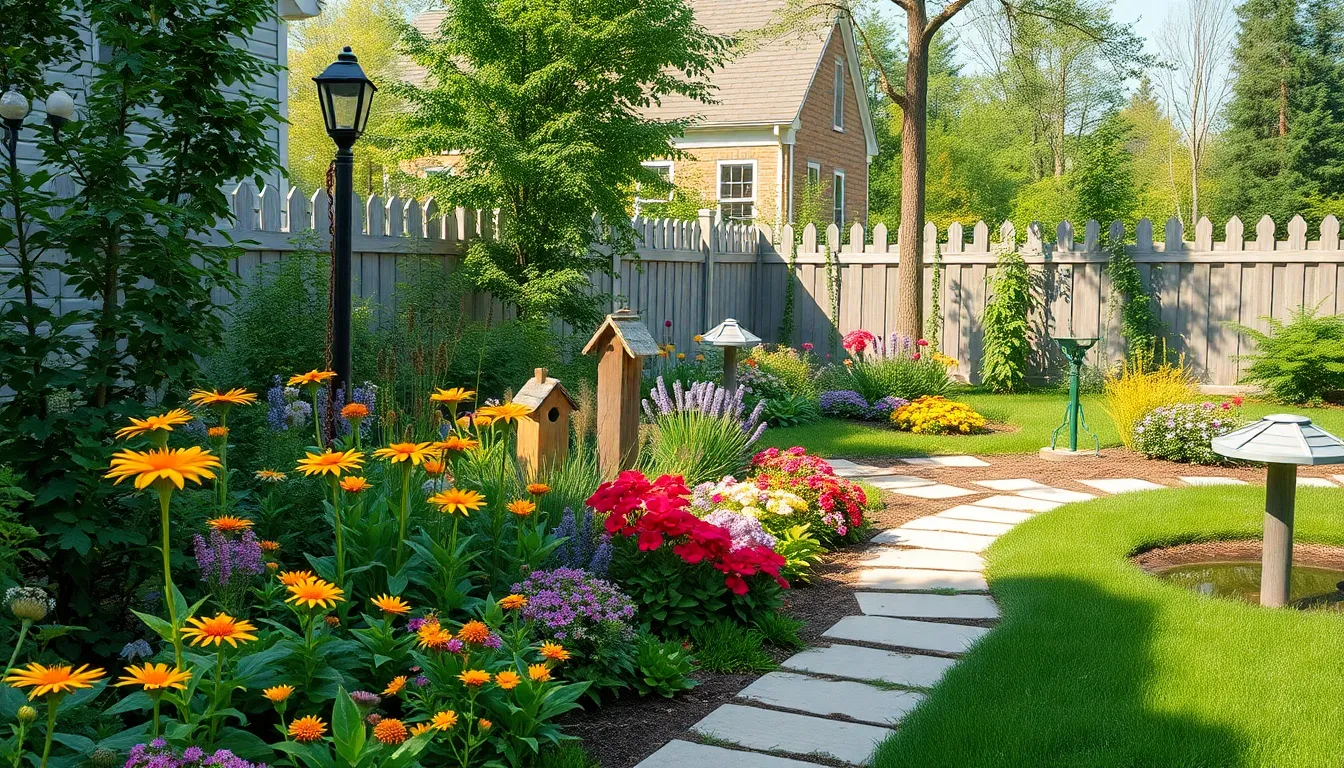
We can transform our gardens into environmentally responsible spaces that benefit both our households and local ecosystems. These green renovation strategies reduce maintenance costs while supporting biodiversity and conservation efforts.
Design Rain Gardens and Native Plant Areas
Rain gardens and bioswales collect and filter rainwater naturally, reducing runoff and preventing soil erosion. These shallow basins use native, water-tolerant species to treat stormwater while creating attractive industry features. Installing these systems in low-lying areas or near downspouts captures excess water during heavy rainfall.
Native plant zones support local wildlife while requiring minimal maintenance and water usage. These dedicated areas attract pollinators like bees and butterflies, contributing to healthy garden ecosystems. Selecting indigenous flora means plants naturally resist local pests and diseases without chemical interventions.
Grouping plants with similar water needs maximizes irrigation efficiency and reduces resource waste. Native species typically thrive with less frequent watering once established, making them ideal for sustainable garden design. Creating these zones also simplifies maintenance schedules and fertilizer applications.
Install Solar-Powered Garden Elements
Solar lighting systems provide energy-efficient illumination without increasing electricity costs or environmental impact. LED fixtures powered by solar panels operate independently from the grid while offering reliable pathway and accent lighting. These systems automatically charge during daylight hours and activate at sunset.
Solar water features like fountains and irrigation pumps conserve energy while adding aesthetic appeal. These installations operate without electrical connections, making them ideal for remote garden areas or water-wise landscapes. Solar-powered pumps also support drip irrigation systems that deliver water directly to plant roots.
Energy-independent garden tools reduce our carbon footprint while maintaining functionality. Solar-powered timers, sensors, and controllers automate garden care without drawing from household electrical systems. These technologies integrate seamlessly with existing smart home networks for remote monitoring.
Create Wildlife-Friendly Habitat Zones
Pollinator gardens attract beneficial insects that support plant reproduction and garden health. Planting flowers that bloom throughout growing seasons provides consistent food sources for bees, butterflies, and birds. These areas also contribute to integrated pest management by supporting natural predators.
Shelter and nesting sites encourage wildlife to establish permanent residence in our gardens. Installing birdhouses, bat boxes, and small ponds creates habitat diversity that supports ecological balance. These features also provide natural pest control as wildlife consumes harmful insects.
Low-maintenance ground covers replace traditional lawns while offering habitat for beneficial insects. Drought-resistant options like native grasses and creeping plants reduce mowing and watering requirements significantly. These alternatives also prevent soil compaction and erosion while supporting underground ecosystems.
Conclusion
Garden renovation doesn’t have to be overwhelming or expensive. We’ve shown you that strategic planning and thoughtful design choices can transform any outdoor space into a stunning retreat that reflects your personal style.
Whether you’re starting with simple plant replacements or implementing smart technology answers the key is choosing projects that align with your lifestyle and maintenance preferences. From hardscaping elements to privacy screens every addition should serve both functional and aesthetic purposes.
Your garden renovation journey is unique to your space needs and vision. Start with one or two projects that excite you most and build from there. With proper planning and the right approach you’ll create an outdoor sanctuary that enhances your property value and brings years of enjoyment.
Frequently Asked Questions
What’s the most cost-effective way to transform my garden?
Start with small strategic changes like updating plant beds, adding decorative pathways, and installing simple lighting. Focus on native plants and low-maintenance perennials to reduce long-term costs. These budget-friendly improvements can significantly enhance your garden’s appearance without requiring extensive renovations or professional help.
How do I create a garden layout plan for my space?
Begin by assessing your current space: measure dimensions, document sunlight patterns, test soil quality, and evaluate drainage. Then design functional zones for different activities, establish pathways, and plan for seasonal interest with varied plant bloom times. Choose a cohesive style theme that complements your home’s architecture.
What hardscaping elements should I prioritize in my garden renovation?
Focus on decorative pathways using materials like flagstone or brick for structure and flow. Consider retaining walls or raised beds to address drainage and make maintenance easier. Water features like fountains can enhance ambiance, while pergolas provide shade and architectural interest to your outdoor space.
How can I ensure my garden looks good throughout all seasons?
Select plants with staggered bloom times and incorporate evergreen elements for year-round structure. Layer different plant heights for visual depth and choose native species that thrive in your local conditions. Include seasonal features like ornamental grasses and plants with interesting winter bark or seed heads.
What outdoor living upgrades provide the best return on investment?
Build comfortable seating areas with durable furniture and add fire pits for warmth and ambiance. Install smart lighting systems for evening enjoyment and safety. Create dedicated dining zones with outdoor kitchens or multifunctional furniture. These upgrades extend your home’s usable space and increase property value.
How do I choose the right lighting for my garden?
Use layered lighting techniques combining pathway lights, accent spotlights, and decorative string lights. Solar-powered options are energy-efficient and easy to install. Include motion sensor lights for security and adjustable spotlights to highlight key garden features. Focus on creating both functional illumination and magical ambiance.
What smart technology can help with garden maintenance?
Install drip irrigation systems and smart sprinkler controllers that adjust watering based on weather conditions. Use automated garden care systems that integrate with smart home technology for remote monitoring. Digital soil sensors can track moisture levels, while smart composting systems help manage organic waste efficiently.
How can I create privacy in my garden without major construction?
Plant natural privacy hedges with fast-growing evergreen shrubs for year-round coverage. Install decorative fencing or trellises that provide function while enhancing visual appeal. Create intimate garden rooms using strategic planter arrangements, free-standing walls, or garden awnings that define spaces without permanent changes.
What are the best sustainable features to include in my garden?
Create rain gardens with native plants to manage stormwater naturally. Install solar-powered lighting and water features for energy efficiency. Establish wildlife-friendly habitat zones with pollinator gardens and nesting sites. Use composting systems and choose drought-tolerant plants to reduce water consumption and maintenance needs.
How do I maintain a low-maintenance garden that still looks beautiful?
Choose native and drought-tolerant plants that thrive in your local conditions. Group plants with similar water and care requirements together. Install automated irrigation systems and use mulch to reduce weeding. Select perennial plants over annuals and incorporate evergreen elements for consistent year-round structure and appeal.

